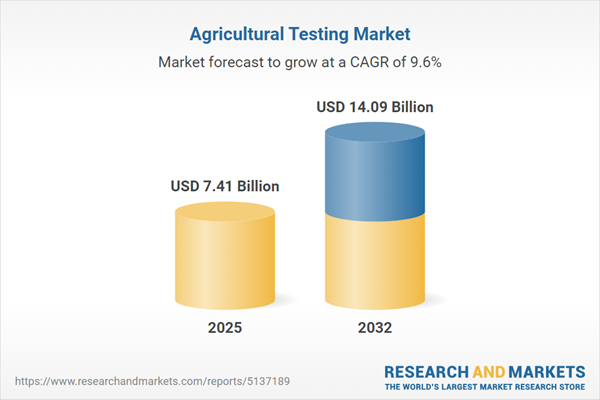Speak directly to the analyst to clarify any post sales queries you may have.
Senior decision-makers in the agricultural industry are focusing on advanced agricultural testing as a key instrument to achieve resilient operations, regulatory compliance, and strong supply chain security in a landscape shaped by evolving market and environmental pressures.
Agricultural Testing Market Snapshot
The agricultural testing market currently stands at USD 6.76 billion, with growth projected to reach USD 7.41 billion by 2025 and USD 14.09 billion by 2032. Rising awareness around food safety and the necessity for sustainable practices is shifting market dynamics and accelerating adoption of robust testing solutions. Enterprises and laboratories increasingly adopt comprehensive diagnostic frameworks to align with consumer demand, regulatory change, and the need for adaptive business strategies. By integrating standardized protocols, organizations can proactively address risks, ensure compliance, and strengthen operational agility in an increasingly complex regulatory environment.
Agricultural Testing Market Scope & Segmentation
This analysis provides actionable guidance for organizations seeking to optimize investment, maintain regulatory rigor, and adapt swiftly to sector developments. Strategic segmentation underpins operational efficiency and tailored compliance approaches across major industry facets:
- Test Types: Microbial, plant tissue, seed, soil, and water testing enables early contamination detection, crop health management, yield optimization, and strengthened food safety initiatives.
- Crop Types: Segmented testing for cereals, grains, fruits, vegetables, oilseeds, and pulses equips enterprises to anticipate supply chain shifts and evolving end-user requirements.
- Technologies: Incorporating gas chromatography, high-performance chromatography, PCR, and spectroscopy allows organizations to advance diagnostic accuracy, demonstrate compliance, and support sustainable production.
- Service Modes: Both laboratory-based and on-site testing options drive fast response—either for routine checks or targeted, immediate needs—supporting operational resilience.
- End Users: This includes agricultural institutions, research organizations, regulatory agencies, and both public and private laboratories, all of whom rely on robust testing for traceability and reliable oversight.
- Applications: Core areas span contamination screening, soil fertility assessment, quality control, and safety verification, reinforcing client trust and supporting risk management objectives.
- Regions: The market examines North America, Latin America, Europe, Middle East & Africa, and Asia-Pacific, outlining distinct regulatory landscapes and informing locally optimized approaches.
Agricultural Testing Market: Key Takeaways
- Ongoing digital transformation is continually enhancing the speed and transparency of agricultural testing processes, helping organizations respond swiftly to operational and regulatory insights.
- Independently verified, traceable testing frameworks are increasingly vital for achieving ESG and sustainability objectives and for strengthening brand confidence with business partners.
- Laboratory modernization, combined with ongoing technical skill development, addresses emerging compliance standards and preserves market relevance.
- Collaboration across the value chain—between tech providers, regulators, and industry actors—spurs process standardization and supports adoption of best practices at scale.
- Utilizing deep local and regional expertise in Asia-Pacific and EMEA helps organizations successfully address unique market challenges and align with evolving, region-specific regulations.
- The adoption of AI-driven automation and portable diagnostics further boosts testing reliability and operational efficiency, laying the groundwork for predictive, data-informed decision-making.
Tariff Impact: Navigating Cost Structures and Supply Disruptions
Recently introduced U.S. tariffs on laboratory equipment and related materials are compelling agricultural testing providers to adapt their supply chains and cost structures. In response, industry leaders are turning to localized sourcing, accelerating internal process optimization, and engaging in selective partnerships, supporting the continuity of essential testing and analytical capabilities during periods of global supply disruption.
Methodology & Data Sources
Insights for this report are drawn from ongoing interviews with senior and technical experts, targeted analysis of regulatory updates, and cross-verified secondary research. This triangulation ensures objectivity and practical value for executive-level planning within the agricultural testing sector.
Agricultural Testing Market: Why This Report Matters
- Empowers leaders to allocate resources efficiently, strengthen workforce skills, and embed sustainable practices across diverse operating environments.
- Supports successful technology integration and enables regionally tailored responses to regulatory and supply chain developments, reinforcing risk management and continuity planning.
- Delivers a structured, actionable framework for consistent compliance and operational improvement, encouraging innovation and long-term business adaptability.
Conclusion
Sustained sector growth will rely on targeted technology investments, strong collaboration, and a proactive approach to evolving regulatory demands. Organizations attentive to these drivers are positioned to successfully navigate ongoing changes and future uncertainties in agricultural testing.
Additional Product Information:
- Purchase of this report includes 1 year online access with quarterly updates.
- This report can be updated on request. Please contact our Customer Experience team using the Ask a Question widget on our website.
Table of Contents
3. Executive Summary
4. Market Overview
7. Cumulative Impact of Artificial Intelligence 2025
Companies Mentioned
The companies profiled in this Agricultural Testing market report include:- Eurofins Scientific SE
- SGS S.A.
- Intertek Group PLC
- Bureau Veritas S.A.
- ALS Limited
- Mérieux NutriSciences SAS
- Cotecna Inspection S.A.
- EMSL Analytical, Inc.
- Microbac Laboratories, Inc.
- NSF International
Table Information
| Report Attribute | Details |
|---|---|
| No. of Pages | 187 |
| Published | November 2025 |
| Forecast Period | 2025 - 2032 |
| Estimated Market Value ( USD | $ 7.41 Billion |
| Forecasted Market Value ( USD | $ 14.09 Billion |
| Compound Annual Growth Rate | 9.6% |
| Regions Covered | Global |
| No. of Companies Mentioned | 11 |









